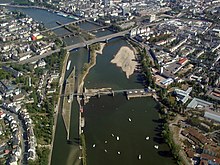Traffic jam control
A congestion control generated by incorporation of barrages improved water level ratios for shipping and / or use of water power in a river.
term
In the past, the terms congestion control and canalization were often used synonymously. According to DIN 4054 (September 1977), the synonym canalization is no longer applicable because it leads to the misunderstanding that such a developed river becomes a canal . The DIN defines a shipping canal as a waterway with a predominantly artificial water bed (e.g. Dortmund-Ems Canal with 72%, Main-Danube Canal with 70%). The conversion of a natural watercourse into a canal ("canalization") was the rule at the beginning of the making of smaller watercourses navigable, but has only occurred in a few cases with today's shipping canals, such as the Elbe-Lübeck Canal , Finow Canal , Landwehr Canal and Werbellink Canal . It is characteristic of these waterways that they have a weir to regulate the discharge at the canal steps next to the lock (shipping canals normally only have locks or lifting works and possibly pumping stations for feeding the canal as well as boat systems at the canal steps.)
Almost all rivers in Germany that are regulated by impoundment, on the other hand, have largely retained a natural river bed, even if the banks were fortified to protect them against suction and waves from the ships. Sections with an artificial river bed are usually punctures for cutting off river loops. Such punctures are used in many cases for the installation of the locks and are then called lock canals (e.g. on the Main , Mosel , Mittelems and Mittelweser ). In some cases there are lock canals that run parallel to the river (e.g. near Elde and Neckar ).

Buildings
A barrage consists of several structures, namely the
- Weir system to raise the water level and to regulate the discharge, often combined with a hydroelectric power station; In the case of lock canals, the weir is in the arm of the river, the so-called weir arm; in the case of wide rivers, a weir can be supplemented by a dam (e.g. Rhine barrage Iffezheim ),
- Ship lock system with one lock or several locks to overcome the difference in height of the barrage, the height of fall by lifting or lowering ships by filling or emptying the lock chamber, occasionally combined with a hydroelectric power plant, integrated in the lock channel or in its own power plant channel,
- Boat system for small watercraft, especially sport boats, in the form of a boat lock, boat lane , boat tow or boat stairs.
- Fish pass , which is supposed to guarantee a (so-called biological) passage for fish. A fish pass has not yet been integrated into all dams in Germany.
If the weir and lock are next to each other in the river, the access to the lock is separated by separating piers / dams to protect the ships against the weir's water currents.
The section between two adjacent barrages is the retention ; A distinction must be made between this and the accumulation area as a route above a barrage where the accumulation affects the water levels.
Effects
Flood
The opinion that dam control increases the flood levels is incorrect. Barrages are generally dimensioned by the width and number of weir openings so that floods can flow off unhindered, i.e. not be dammed.
natural reserve
There are a number of weighty objections on the part of nature conservation (see also water protection ) to a dam regulation. This is particularly evident from the decades-long dispute about the regulation of the damming of the last free flowing 70 km Danube in Germany between Straubing and Vilshofen , which is undoubtedly a bottleneck in the Danube for shipping. Despite the near-natural development of rivers in recent decades (e.g. lower course of the Altmühl ), flora and fauna are changing due to the changed water levels and flow speeds.
The downstream expansion of the Czech dam regulation of the Elbe through the planned construction of the Děčín barrage near the border with Germany is encountering resistance, especially in neighboring Saxony . Among other things, disadvantages for the unregulated German upper reaches of the Elbe are feared.
See also
Individual evidence
- ↑ a b c d e f g h i j k DIN 4054 hydraulic engineering; Terms; September 1977
- ↑ a b DIN 4048-1 hydraulic engineering; Terms; Dams; January 1987
- ↑ DIN 4047-5 Agricultural hydraulic engineering; Terms; Expansion and maintenance of waters; March 1989
- ^ Fraction BÜNDNIS 90 / DIE GRÜNEN in the Saxon state parliament: The Elbe - river landscape or shipping lane? (PDF; 631 kB); 2007